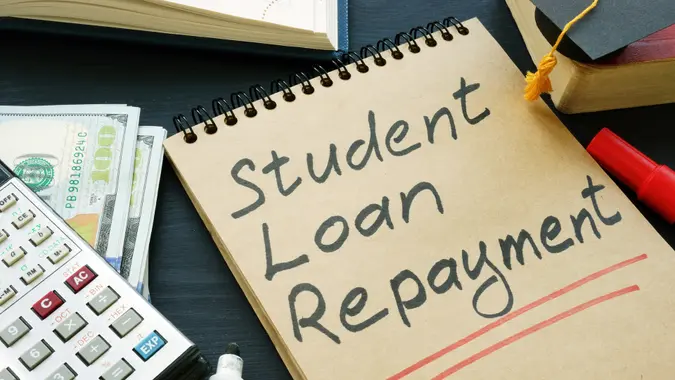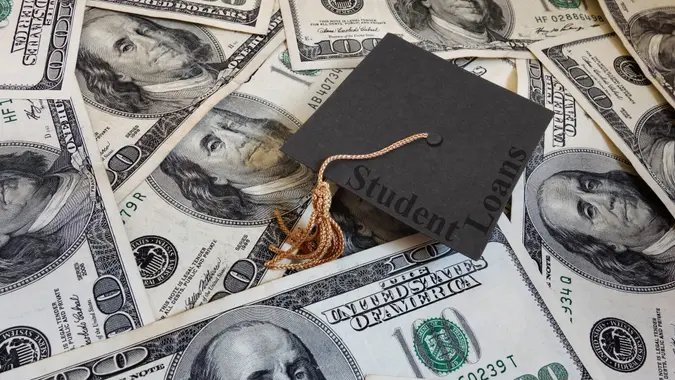How Do Federal Student Loans Work?

Commitment to Our Readers
GOBankingRates' editorial team is committed to bringing you unbiased reviews and information. We use data-driven methodologies to evaluate financial products and services - our reviews and ratings are not influenced by advertisers. You can read more about our editorial guidelines and our products and services review methodology.

20 Years
Helping You Live Richer

Reviewed
by Experts

Trusted by
Millions of Readers
On the surface, federal student loans are straightforward: You borrow money from the government to go to school, and when you get a job, you pay it back. In reality, the student loan process is a bit more complicated. Learning how to get federal student loans and what kind of financial aid package you might qualify for are important first steps.
Here’s a look at how getting financial aid for college works.
What Are Federal Student Loans?
A federal student loan is a loan made by the U.S. government that usually offers borrowers more flexible repayment options and a lower interest rate than a private loan. These loans are offered by the U.S. Department of Education and available to undergraduate, graduate and professional students.
Types of Federal Student Loans
Here’s a look at the different types of federal student loans:
Direct Subsidized Loans
These are loans for undergraduate students demonstrating financial need. The government covers interest while the borrower is in school and during deferment, though it starts to accrue once the borrower begins making payments.
Direct Unsubsidized Loans
These are loans for undergraduate, graduate and professional students, and there’s no financial need requirement. Interest accrues immediately, even while in school.
Direct PLUS Loans
These loans are for graduate students and the parents of dependent undergraduates. They require a credit check and may have higher interest rates.
Direct Consolidation Loans
This loan type allows borrowers to combine multiple federal loans into one. It can simplify payments, but may increase the total interest paid on the loan.
How To Apply For Federal Student Loans
Regardless of income, most students qualify for at least some type of financial aid for college. The first step to apply for a student loan is to complete a Free Application for Federal Student Aid.
1. Fill Out the FAFSA
Here’s the information you’ll need to complete a FAFSA:
- Social Security number
- Alien registration number — if you’re not a U.S. citizen
- Federal income tax returns, including W-2s and other records of income
- Bank statements/investment records
- Records of untaxed income
- An FSA ID
You’ll also need to file your parents’ information if you’re a dependent.
After submitting your FAFSA either online or via mail, you’ll receive a Student Aid Report so you can verify that your FAFSA information is accurate. Then, the information will be sent to the schools you listed on your FAFSA so that they can calculate your aid offer.
2. Review Your Loan Offer
Once your FAFSA has been processed, schools will provide a financial aid package based on the results. After you receive this package you can compare the types and amounts of the loans offered, and get an idea of which work best for you.
3. Accept Your Loan and Sign a Master Promissory Note (MPN)
After deciding on your loan or loans, inform your school’s financial aid office. You’ll need to sign a Master Promissory Note (MPN) — a legally binding agreement which contains the terms and conditions of your federal loan agreement, and your promise to pay it back. Then you can start receiving funds.
4. Complete Loan Entrance Counseling
If you’re a first-time borrower, you’ll need to go to an online session of loan entrance counseling, which explains loan terms and responsibilities so you’re fully aware of what you’re getting into.
Can You Consolidate Federal Student Loans?
Federal student loan consolidation can be an option for borrowers with more than one loan. A direct consolidation loan can allow you to consolidate multiple loans into a single loan, which results in one student loan payment and can reduce the interest on federal student loans.
The government also offers a number of student loan forgiveness options, which can help you wipe out your remaining debt if you meet certain qualifications.
Federal Student Loans vs. Private Student Loans: Key Differences
Federal student loans are funded by the U.S. government. Private student loans are funded by non-governmental financial institutions, such as banks, credit unions, state agencies or schools. Check out the other differences outlined in the following table:
| Federal vs. Private Student Loans | ||
| Requirements and Options | Federal Student Loans | Private Student Loans |
| Repayment | Typically after school | Typically while in school |
| Interest rate | Fixed | Fixed or variable |
| Subsidized | Typically, yes | No |
| Credit Check | No, except for PLUS loans | Possible |
| Cosigner | Not required | Might be required |
| Deferment Options | Possible | Typically, no |
| Prepayment Penalties | No | Possible |
| Loan Forgiveness Options | Numerous options | Unlikely |
| Tax-Deductible Interest Options | Typically, yes | Typically, no |
Pros and Cons of Federal Student Loans
Here’s a quick look at some pros and cons of federal student loans:
Pros:
- Lower, fixed interest rates as compared to private loans
- Credit check is not required for most loans
- Flexible repayment and forgiveness options
Cons:
- Loan limits may not cover the full costs of college
- Interest accrues on unsubsidized loans while in school
- Can take years to repay
How To Manage and Repay Your Federal Student Loans
One thing you don’t want to do is ignore your federal student loans after taking them. Here are some steps that should help you manage and repay them over time, so they don’t negatively impact your finances:
- Keep track of your loan balances through StudentAid.gov so you know how much you have to pay back, and if interest starts to run your loans up
- Make payments on time to avoid late fees and default
- Consider an income-driven repayment plan if you’re struggling with your payments
- If eligible, apply for loan forgiveness programs
Final Thoughts: Are Federal Student Loans Right for You?
Federal student loans provide affordable financing for many college students. They offer flexible repayment options, lower interest rates and protections that are not typically available with private loans, which is why they’re so popular.
However, taking out any loan is still a major financial responsibility and you should be aware of all it entails before signing an agreement. When pursuing higher education, it’s advisable to borrow only what you need. Explore grants and scholarships before borrowing, and consider working a part-time job to help cover living costs or part of your education costs while in school.
FAQ
- Do I have to repay federal student loans while in school?
- No. If you're enrolled in at least half of a full course load, typically your loans will be placed on deferment until after graduation. However, on some loan types interest will begin to accrue while you're in school.
- What happens if I can’t afford my loan payments?
- If you default on your student loans, your loans could be sent to collections -- which can lead to consequences like wage garnishment and the withholding of your tax returns. Your credit score will also take a severe hit and make it difficult for you to rent, buy a home or take out any other type of loan. If you can't afford your payments, you should reach out to your servicer and ask about different repayment options to see if you can negotiate something.
- Can I refinance a federal student loan?
- Technically yes, but to do so you'd have to take out a private loan to cover the cost of the federal one. This is only really a good idea if you can qualify for lower rates with a private lender.
- What is the maximum amount I can borrow in federal student loans?
- This depends on whether you're an undergraduate or graduate student, if you're a dependent and what type of loan/loans you take out. Find out more on StudentAid.gov about loan amount limits.
 Written by
Written by  Edited by
Edited by 























